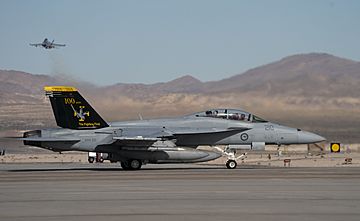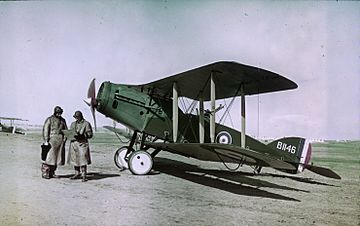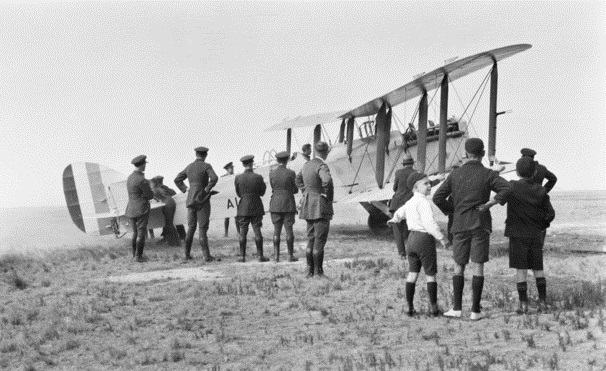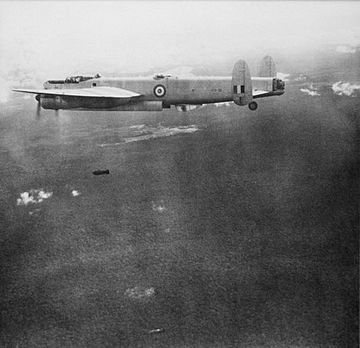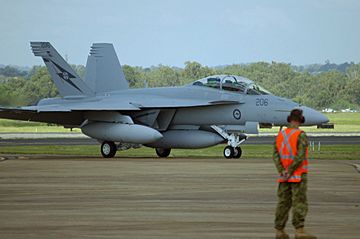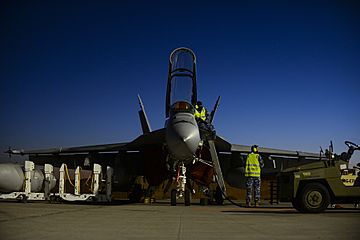No. 1 Squadron RAAF facts for kids
Quick facts for kids No. 1 Squadron RAAF |
|
|---|---|
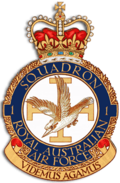
No. 1 Squadron's crest
|
|
| Active | 1916–1919 1925–1942 1943–1946 1948–current |
| Country | Australia |
| Branch | Royal Australian Air Force |
| Role | Air-to-air/air-to-surface combat |
| Part of | No. 82 Wing |
| Garrison/HQ | RAAF Base Amberley |
| Nickname(s) | "Fighting First" |
| Motto(s) | Videmus agamus (Latin: "We Seek and We Strike") |
| Engagements | World War I World War II Malayan Emergency War against the Islamic State |
| Battle honours | Egypt 1915–1917 Palestine 1917–1918 Malaya 1948–1960 |
| Commanders | |
| Notable commanders | Edgar Reynolds (1916) Richard Williams (1917–18) Harry Cobby (1925–26) Raymond Brownell (1926–28) Frank Lukis (1930, 1932–34) Frank Bladin (1934–35) Alan Charlesworth (1936–39) Allan Walters (1940–41) Errol McCormack (1978–79) Leo Davies (2002–03) |
| Aircraft flown | |
| Attack | F/A-18F Super Hornet |
No. 1 Squadron is a special group in the Royal Australian Air Force (RAAF). They are based at RAAF Base Amberley in Queensland, Australia. This squadron is part of No. 82 Wing and flies powerful Boeing F/A-18F Super Hornet jets. These jets are used for both air-to-air (fighting other planes) and air-to-surface (attacking targets on the ground or sea) missions.
The squadron started way back in 1916 during World War I. They flew older planes in the Sinai and Palestine campaign. After the war, the squadron was temporarily closed in 1919. It was brought back to life in 1925 as an active unit. Over the years, they flew many different types of aircraft, from early biplanes to modern jet fighters.
During World War II, No. 1 Squadron was involved in battles in Malaya and the Dutch East Indies. They faced tough challenges and suffered many losses. After the war, they became a heavy bomber unit. From 1950 to 1958, they were based in Singapore and played a big role in the Malayan Emergency, fighting against communist groups. They dropped a huge amount of bombs during this time.
In more recent times, No. 1 Squadron flew the General Dynamics F-111C "swing-wing" bomber for 37 years. In 2010, they switched to the Boeing F/A-18E/F Super Hornet. These Super Hornets have been used in real missions, like helping in the War against the Islamic State in the Middle East in 2014–15 and again in 2017.
Contents
What They Do and What They Fly
No. 1 Squadron is stationed at RAAF Base Amberley in Queensland. They are part of No. 82 Wing, which is a key part of the RAAF's Air Combat Group. Their main jobs include fighting other aircraft in the sky and attacking targets on the ground or at sea. People often call them the "Fighting First."
The squadron's special symbol, called a blazon, shows an Australian Kookaburra diving down over a Jerusalem cross. This symbol remembers a brave act by pilot Frank McNamara during World War I, where he won the Victoria Cross. The squadron's motto is Videmus Agamus, which means "We see and we strike."
Today, the squadron flies Boeing F/A-18F Super Hornet jets. These jets are also known as "Rhinos." They can do many different types of missions, such as:
- Controlling the sky (air superiority)
- Protecting other planes (fighter escort)
- Attacking targets on land (land strike)
- Attacking ships at sea (maritime strike)
- Helping ground troops (close air support)
- Gathering information (reconnaissance)
The Super Hornet is bigger than older Hornet jets. It can carry more weapons and has more fuel. It has a 20 mm cannon and can carry different types of missiles and bombs. Two people fly the Super Hornet: a pilot and an air combat officer. They can attack targets in the air and on the ground at the same time. These jets can also refuel in the air from other RAAF planes like the Airbus KC-30A Multi Role Tanker Transports.
A Look Back: History
World War I Adventures
No. 1 Squadron started as part of the Australian Flying Corps (AFC) in January 1916. They sailed to Egypt and joined up with the British Royal Flying Corps (RFC). At first, they flew old planes like the Royal Aircraft Factory B.E.2 biplanes. Their main jobs were to scout ahead, take aerial photos, and help guide artillery fire for the British Army.
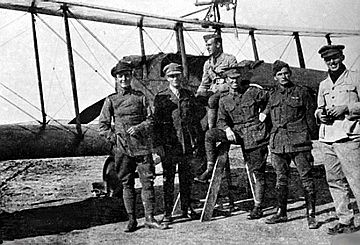
In 1916, the British started calling them No. 67 (Australian) Squadron RFC. But by 1918, they were officially No. 1 Squadron AFC again. The squadron was known for being less formal than British units. Pilots and ground crew worked closely together. They started getting better planes, like the Martinsyde G.100 fighters, which were faster and had machine guns.
In March 1917, they carried out many bombing missions. During one mission, Lieutenant Frank McNamara bravely landed his plane under enemy fire to rescue another pilot. For this, he earned the Victoria Cross, a very high award for bravery. The squadron also took part in the First Battle of Gaza and the Second Battle of Gaza.
Later in 1917, they finally received modern planes like the Royal Aircraft Factory R.E.8 and the Bristol F.2 Fighter. These new planes helped them fight the enemy in the air much better. In 1918, they started winning aerial battles. They also helped Colonel T.E. Lawrence's Arab army and used a large bomber called the Handley Page Type O.
In September 1918, they played a big part in the Battle of Armageddon, causing a lot of damage to the Turkish army. After the war ended in October 1918, the squadron returned to Australia in 1919 and was disbanded.
Between the World Wars
No. 1 Squadron was officially re-formed in 1922 as part of the new Royal Australian Air Force (RAAF). However, due to money problems, it was soon put on hold. It became an active unit again in 1925, based at Point Cook. At this time, it was a "composite" unit, meaning it had different types of planes for different jobs, like army support and bombing.
They moved to RAAF Laverton in 1928. Over these years, No. 1 Squadron did many helpful tasks. These included helping during floods and bushfires, searching for lost people, and doing aerial surveys. In 1930, one of their planes even did Australia's first crop-dusting operation!
In the 1930s, RAAF squadrons started focusing on specific roles. No. 1 Squadron became a bomber unit, flying planes like the Hawker Demon and Westland Wapiti. By 1939, as war seemed more likely, they switched to Avro Anson planes for reconnaissance and bombing.
World War II Missions
When World War II began, No. 1 Squadron's Ansons patrolled the seas and escorted ships. In 1940, they became the first RAAF unit to fly the Lockheed Hudson aircraft. They were sent to Malaya for maritime reconnaissance.
On December 7/8, 1941, their Hudsons spotted the Japanese invasion fleet. They launched attacks on the Japanese landing at Kota Bharu, becoming the first aircraft to attack in the Pacific War. They sank one Japanese transport ship and damaged two others. However, they suffered heavy losses and had to retreat.
The squadron continued to fight in the Dutch East Indies campaign, attacking Japanese bases and convoys. They faced many more losses and by March 1942, their remaining planes had to withdraw to Australia. Many of their personnel were captured by the Japanese.
No. 1 Squadron was re-formed in December 1943 with Bristol Beaufort planes. They flew reconnaissance and bombing missions in Timor. In 1945, they switched to de Havilland Mosquito fighter-bombers for operations in the Dutch East Indies. After the war ended, the squadron was disbanded again in 1946.
The Malayan Emergency and Jet Age
In 1948, No. 1 Squadron was brought back as a heavy bomber unit, flying Avro Lincoln planes. From 1950 to 1958, they were based in Singapore and played a major role in the Malayan Emergency. They flew many bombing missions against communist guerrillas, often dropping bombs and using their machine guns. The Lincolns were good for this job because they could fly far and slow, and carry a lot of bombs.
The squadron did not lose any crew members during this campaign. They dropped over 14,000 tonnes of bombs, which was 85% of all bombs dropped by Commonwealth forces during the Emergency. This was the last time the squadron took part in combat operations for many years.
After returning to Australia, No. 1 Squadron started flying English Electric Canberra jet bombers. These were the RAAF's first jet bombers. In 1968, they prepared to switch to the General Dynamics F-111C supersonic bomber. However, the F-111 program was delayed. So, from 1970 to 1973, No. 1 Squadron flew McDonnell Douglas F-4E Phantoms as a temporary solution. The Phantom was a big step up from the Canberra.
In 1973, No. 82 Wing received its first F-111Cs. No. 1 Squadron was the main strike force for the wing. The F-111 was a very advanced aircraft with special "swing-wings" and terrain-following radar. It could fly very fast (Mach 2.5) and reach targets far away. Over its 37 years of service, the F-111 received many upgrades, including precision weapons systems.
The F-111s were almost used in action during operations in East Timor in 1999. No. 1 Squadron's F-111s were ready to fly reconnaissance or air strikes if needed, but they were only used for scouting missions.
In 2007, the Australian government decided to retire the F-111s because they were getting old and expensive to maintain. In 2010, No. 1 Squadron stopped flying the F-111 and became the first squadron outside the United States to fly the Boeing F/A-18E/F Super Hornet. This new multi-role jet allowed the squadron to do both offensive strikes and air-to-air combat.
In 2014, the government decided to send up to eight Super Hornets from No. 1 Squadron to the Middle East. This was part of Operation Okra, Australia's contribution to the War against the Islamic State. The Super Hornets flew their first mission over Iraq in October 2014 and dropped their first bombs a few days later. They flew many missions, destroying or damaging many targets.
In 2016, No. 1 Squadron celebrated its 100th birthday! In 2017, a group from No. 1 Squadron was sent to the Middle East again. They flew the last strike mission for the Australian Air Task Group in January 2018. In 2020, some of No. 1 Squadron's Super Hornets and training were moved to a new unit called No. 82 Wing Training Flight.
Aircraft operated
- Royal Aircraft Factory B.E.2/B.E.12 (1916–1918)
- Martinsyde G.100/G.102 (1916–1918)
- Royal Aircraft Factory R.E.8 (1917–1918)
- Bristol F.2 Fighter (1917–1919)
- Handley Page O/400 (1918)
- Airco DH.9/DH.9A (1925–1929)
- Royal Aircraft Factory S.E.5 (1925–1928)
- Westland Wapiti (1929–1936)
- Hawker Demon (1935–1939)
- Bristol Bulldog (1935–1937)
- Avro Anson (1939–1940)
- Lockheed Hudson (1940–1942)
- Bristol Beaufort (1943–1945)
- De Havilland Mosquito (1945–1946)
- Avro Lincoln (1948–1958)
- English Electric Canberra (1958–1970)
- McDonnell Douglas F-4 Phantom II (1970–1973)
- General Dynamics F-111C (1973–2009)
- Boeing F/A-18F Super Hornet (2010–current)


